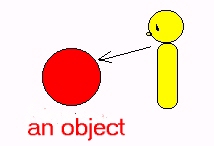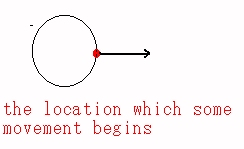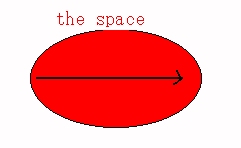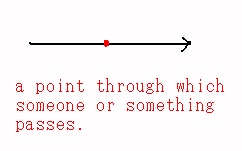Japanese
* JAPNESE HOME PAGE IS HERE
"o"
- It's been a long time since we wrote the last article.
This month we'll tell you the particle "o".
It has several usages as follows.
1. (1)Hon o yomimasu.
- (2)kooen de kodomo o asobaseru.
- (3)Musuko no kekkon o yorokobu.
2.Densha o oriru.
3.Tori ga sora o tonde iru.
4.Tsugi no kado o migi ni magatte kudasai.
We'll explain them in this article.
1. "O" marks a direct object.

- (1)Hon o yomimasu.
- Ongaku o kikimasu.(I listen to the music.)
- Hon o yomi mashoo.( Let's read a book)
- Rainen daigaku no shiken o ukeru tsumori desu.
- ( I'll take an entrance exam.to college next year.)
- Ocha o irete agemashoo.( I'll serve you green tea.)
- Nihongo de tegami o kaku.(I write a letter in Japanese.)
- Oyu o wakasu. ( I boil water.)
- Watashi wa tanaka san ni hon o karita.(I borrowed the book from Mr.Tanaka.)
- Tanaka san wa kinoo kanojo ni denwa o kakemashita.(Mr.Tanaka called her yesterday.)
- Juu o utsu na. (Don't shoot the gun)
- Jibun no shita koto ni sekinin o toru.( I take the responsibility for what I have done.)
* It is noted that the direct object in English is not always marked by
- "o" in Japanese.
- ex) Rainen kare to kekkon suru.(I'll marry him next year.)
- Kinoo tomodachi to shinjuku de atta.(I met my friend in Shinjuku yesterday.)
- Sono shirase wa kesa todoita.(The news reached me this morning.)
- (2)Musuko no kekkon o yorokobu
- "O" marks the cause of some human emotion.
- Hito bito wa kare no wakai shi o kanashinda(People felt deep sorrow at his young death.)
- Seito tachi wa daigaku gookaku o yorokondeiru.
- ( Students are pleased at their success in entrance exam.)
- (3)kodomo o asobase masu.
- "O" marks causative object.
- We don't use the particle "o" more than once in a clause.
- So in the causative construction when the verb is intransitive as in (1) "o" is usually used ,
while when the verb is transitive as in (2) "ni" is usually used.
- (1)Musuko o yuujin no kaisha de hatarakasete iru.
- (I forced my son to work for my friend's company.)
- Kodomo o nagai jikan arukaseta.(I made my son walk for a long time.)
- (2)Sensei wa seito ni hon o yomaseru.(The teacher makes the student read
- the book.)
- Kodomo ni yaritai yooni saseru kotomo tokiniwa hitsuyou desu.
- (It is sometimes neccessary to let a child do as he wants to do.)
- koochi wa senshu ni mainichi renshuu o saseta.
- (The coach made the player practice every day.)
2.Densha o oriru.
- "O" marks the location where some movement begins .
- When we use this "o", we focus on a point of detachment.

- Densha wa jikoku doori ni eki o deta.(The train left the station on time.)
- Musuko wa kyonen daigaku o sotsugyoo shita.
- (My son graduated from the university last year.)
- Kesa ie o deta toki ame ga futte ita.(When I left home this morning,it was raining.)
- *The particle "kara" is similar to this usage.
- But when we use "kara", we focus on a starting point and we are conscious of the direction ( from one place to another place).
- ex)Doroboo wa mado kara haitte genkan kara deteitta rashii.
- (It seems that a thief came in through the window and went out of the front door.)
- Kaidan kara ochite kega o shita.(Falling down from the stairs,I was injured in the leg.)
- Higashi kara hi ga noboru.(The sun rises in the east.)
3.Tori ga sora o tonde iru.
- "O" indicates a space in,on,across,through,along which someone or something moves.

- Kyuuna saka o noboru.( I go up a steep slope.)
- Anna kireina hito to kooen o sanpo shitaina.
- ( I want to take a walk with such a beautiful girl in the park.)
- Nihon dewa hito wa migigawa o aruki kuruma wa hidarigawa o hashirimasu.
- (In Japan people walk along the right side of a road and cars
- go along the left side.)
4.Tugi no kado o migi ni magatte kudasai.(Please turn right at the next corner.)
- "O" indicates a point through which someone or something passes.

- Gochuui kudasai. Densha ga sanbansen o tsuuka shimasu.
- (Attention please,the train will pass on the third track.)
- Kooen o tootte gakkoo e kayou.( I go to school passing through the park.)
- Hooan ga ryooin o tsuuka shita.(The bill passed both houses)
- Tonneru o nukeru to fujisan ga mieru.(Passing through the tunnel, you can see the Mt.Fuji.)
- Kuruma wa seigen sokudo o koeta.(The car exceeded the speed limit.)
- Nyuuin seikatsu ga sankagetsu o koeta.(I've been in the hospital for more than three months.)
5.Other expressions of the particle "o"
- Kare wa watashi no hoo o muita.(He turned toward me.)
- Kanojo wa aoi me o shiteiru. (She has blue eyes.)
- Musume ga kekkon shitai to itta toki chichi wa iyana kao o shita.
- (When the daughter said to her father that she would like to marry her boy friend,
- he scowled his displeasure.)
We are expert Japanese teachers. We are confident that this article is good
and useful for foreign learners of Japanese. But we are afraid our English is
not so good. When you find any spelling or grammatical mistake,
please let us know.
We also offer private lessons for students of all levels.
Tel:03-3425-2478 (Matsuyama)
For more information , please call us.
TEL:03-3425-2478(Matsuyama)
EMAIL:BXK04364@niftyserve.ne.jp , o1779uma@ca2.so-net.ne.jp
 /// JAPAN CULTURE STUDY GROUP ///
/// JAPAN CULTURE STUDY GROUP ///
RETURN TO COVER





 /// JAPAN CULTURE STUDY GROUP ///
/// JAPAN CULTURE STUDY GROUP ///